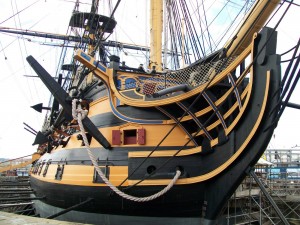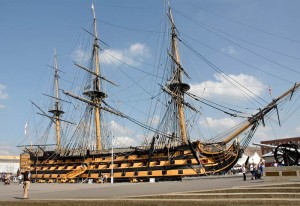Facts About HMS Victory
One of the most famous ships of all time, HMS Victory was instrumental in ensuring British naval supremacy during the late 18th and early 19th centuries.
The only surviving warship to have fought in the American War of Independence, the French Revolutionary War and the Napoleonic wars, the HMS Victory is one of the most famous ships ever to be built.
An imposing first rate ship of the line – line warfare is characterized by two lines of opposing vessels attempting to outmanoeuvre each other in order to bring their broadside cannons into best range and angle-the Victory was an oceanic behemoth, fitted with three massive gundecks, 104 multiple-ton cannons, a cavernous magazine and a crew of over 800. It was a vessel capable of blowing even the largest enemy vessels out of the water with magnificent ferocity and range, while also outrunning and outmanoeuvring other aggressors.
Historically, it was also to be Vice-Admiral Horatio Lord Nelson’s flagship during the epic naval battle off the Cape of Trafalgar, where it partook in the last great line-based conflict of the age, one in which it helped to grant Nelson a decisive victory over the French and Spanish but at the cost of his own life.
![HMS Victory facts HMS Victory facts]() HMS Victory facts
HMS Victory facts
Back-up – Upon completion, the HMS Victory was not put directly 1 into use, but was moored in the River Medway for 13 years until France joined the American War of Independence.
Wood – Building the HMS Victory required over 6,000 trees to be cut down, 90 per cent of which were oak. The other ten per cent consisted of elm, pine, fir and lignum vitae.
Mirabilis – Victory was commissioned to celebrate the Annus Mirabilis (year of miracles) of 1759, where the British achieved great military success against French-led opponents.
Trafalgar – Victory was Nelson’s flagship during the famous Battle of Trafalgar in 1805 which, despite Nelson being mortally wounded, saw the British Navy win a decisive victory.
Rest – The HMS Victory was docked down in No 2 Dock Portsmouth – the oldest dry-dock in the world – in 1922 due to deterioration of its bodywork.
HMS Victory parts
 Sails – The HMS Victory is a fully rigged ship, with three sets of square sails covering 5,440m2. The breadth of the Victory’s sails allowed it to sport a maximum top speed of nine knots when operational, which was for the time very impressive considering its size and weight. During the 18th and 19th centuries a fully rigged ship necessitated three or more masts each of which with square rigging. At full flight the Victory could spread a maximum of 37 sails at one time and could carry 23 spares.
Sails – The HMS Victory is a fully rigged ship, with three sets of square sails covering 5,440m2. The breadth of the Victory’s sails allowed it to sport a maximum top speed of nine knots when operational, which was for the time very impressive considering its size and weight. During the 18th and 19th centuries a fully rigged ship necessitated three or more masts each of which with square rigging. At full flight the Victory could spread a maximum of 37 sails at one time and could carry 23 spares.
Crew – There were over 800 people on board the HMS Victory, including gunners, marines, warrant officers and powder monkeys among many others. Life on board was hard for the sailors, who were paid very little for their services and received poor food and little water. Disease was rife too, and punishments for drunkenness, fighting, desertion and mutiny ranged from flogging to hanging.
Masts – The HMS Victory sported a bowsprit (the pole extending beyond the ship’s head), fore mast, main mast, mizzen mast and main yard. A total of 26 miles (41.9km) of cordage, as well as 768 elm and ash blocks, were used to rig the ship.
Cannons – As a first rate ship of the line, the Victory was a three-gundeck warship with over 100 guns. In fact, the Victory was fitted with 104 cannons: 30 x 2.75 ton long pattern 32-pounders on the gundeck, 28 x 2.5 ton long 12-pounders on the middle gundeck, 30 x 1.7 ton short 12-pounders on the upper gundeck, 12 x 1.7 ton short 12-pounders on the quarterdeck, and 2x medium 12-pounders and 2 x 68-pounder carronades on the forecastle.

